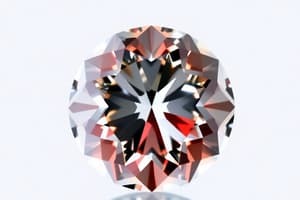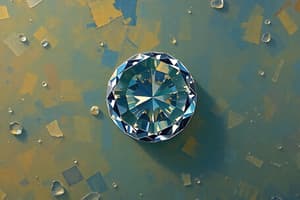Podcast
Questions and Answers
What primarily affects the clarity grade of a diamond?
What primarily affects the clarity grade of a diamond?
- The age of the diamond
- The size, number, location, relief, and nature of clarity characteristics (correct)
- The carat weight of the diamond
- The color of the diamond
What clarity grade is considered "precise" while all others can vary based on the fact the no two diamonds are alike?
What clarity grade is considered "precise" while all others can vary based on the fact the no two diamonds are alike?
- Flawless (correct)
- Slightly Included
- Very Slightly Included
- Included
What is the primary function of a plot in diamond grading?
What is the primary function of a plot in diamond grading?
- To map inclusions, blemishes, and facet arrangement (correct)
- To estimate the carat weight of the diamond
- To provide a market value assessment
- To display the diamond's cut quality
Which of the following statements regarding eye-visible inclusions is correct?
Which of the following statements regarding eye-visible inclusions is correct?
How do blemishes affect the clarity grade of diamonds?
How do blemishes affect the clarity grade of diamonds?
A Clarity Grade is usually determined by ....
A Clarity Grade is usually determined by ....
Accurate clarity grading includes consideration of .....
Accurate clarity grading includes consideration of .....
What size of inclusion has the most influence on the clarity grade?
What size of inclusion has the most influence on the clarity grade?
The GIA Diamond Grading System provides .....
The GIA Diamond Grading System provides .....
What is a contrast between an inclusion and its host gem ?
What is a contrast between an inclusion and its host gem ?
If something is visible without magnification it is what?
If something is visible without magnification it is what?
Inclusions or blemishes that establish the clarity grade of a diamond are what ?
Inclusions or blemishes that establish the clarity grade of a diamond are what ?
Flashcards
Eye-Visible Inclusion
Eye-Visible Inclusion
An inclusion visible to the naked eye, without magnification.
Clarity Grade
Clarity Grade
A diamond's quality rating based on inclusions and blemishes.
Grade-Setting Characteristics
Grade-Setting Characteristics
Inclusions or blemishes determining a diamond's clarity grade.
Diamond Plot
Diamond Plot
Signup and view all the flashcards
Relief (inclusions)
Relief (inclusions)
Signup and view all the flashcards
Study Notes
Diamond Grading System
- Eye-visible: Visible to the naked eye, no magnification needed.
- Grade-setting characteristics: Inclusions or blemishes defining a diamond's clarity grade.
- Plot: A map showing inclusions, blemishes, and facet arrangement.
- Relief: Contrast between an inclusion and its host gem.
Key Concepts
- GIA Diamond Grading System: A universally accepted system for communicating diamond quality.
- Clarity characteristics: Size, number, location, relief, and nature influence clarity grade.
- Large inclusions: Have the strongest impact on clarity grade.
- Diamond uniqueness: No two diamonds are identical, making precise clarity grade descriptions difficult (except flawless).
- Blemishes: Have little to no effect on clarity grades below IF.
- Clarity grading: Primarily determined by the largest and most visible characteristics.
- Visible inclusions: VS, SI, and I clarity stones may include visible inclusions.
- Accurate grading: Considers size and shape of the diamond relative to its clarity characteristics.
Studying That Suits You
Use AI to generate personalized quizzes and flashcards to suit your learning preferences.




